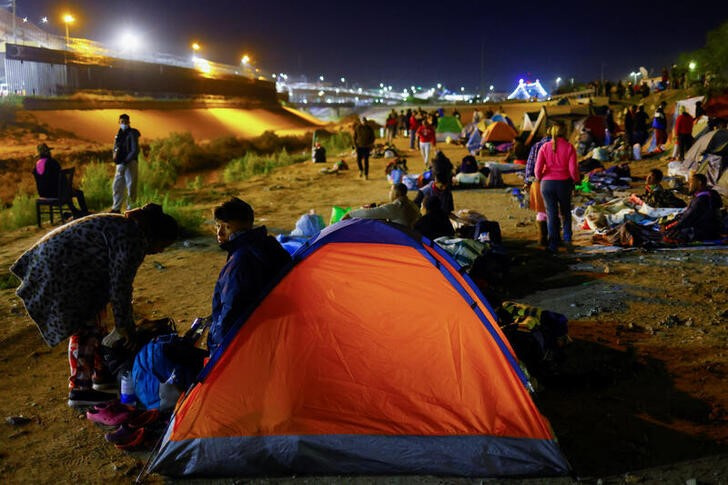By Jackie Botts and Jose Cortes
SAN PEDRO TAPANATEPEC, Mexico – Thousands of migrants are camping in squalid conditions in a remote southern Mexican town after U.S. and Mexican authorities implemented new policies aimed at stemming the illegal flow of Venezuelans into the United States.
Located on a muddy sports field in San Pedro Tapanatepec in Oaxaca state, the camp is the largest in recent Mexican history, according to advocates. About 12,000 people, largely from Venezuela, are sleeping on wooden crates under white canopy tents, on sidewalks, or in residents’ houses and backyards.
The surge of migrants in the small town is straining its infrastructure and fuelling tensions with local authorities who say they are bearing the brunt of shifting U.S. and Mexican immigration policy.
On Tuesday night, after a U.S. judge ruled unlawful a pandemic-era order known as Title 42 used to expel hundreds of thousands of migrants to Mexico, municipal authorities encouraged migrants to form a caravan to head north.
Success
You are now signed up for our newsletter
Success
Check your email to complete sign up
The authorities said they had threatened to empty the camp by organizing caravans unless the federal government dismantled it soon.
Any further large flows of migrants to the U.S.-Mexico border would heap pressure on the administration of President Joe Biden, already facing criticism over its immigration policies from within its own party, as well as from migrant advocates and Republican lawmakers.
“The camp is the worst thing ever, because there’s sickness and there’s filth,” said Jose Maria Lopez, who left his hometown in northwestern Venezuela in September and is in the camp for a second time after authorities detained him near the U.S. border. “It’s uninhabitable,” he added.
At night, the tents echo with coughing, children crying, and the buzz of mosquitoes.
By day, migrants jostle in sweltering heat to be added to lists determining when Mexico’s National Migration Institute (INM) will give them a temporary migration document for travel within the country. Several migrants told Reuters they had waited for over a month.
The buildup of people at the camp underscores Mexico’s efforts to cooperate with the U.S. goal of keeping migrants from advancing to its border.
Under a joint plan announced Oct. 12, aimed at quelling a record influx of Venezuelan migrants, U.S. migration authorities have been expelling Venezuelans caught crossing illegally back to Mexico under Title 42.
INM also implemented new procedures in southern Mexico.
It established the pop-up migration office in San Pedro Tapanatepec in August to process migration documents, and migrants soon began camping in and around the facilities.
In early October, authorities added a stamp saying the documents are only valid within Oaxaca state. That led to migrants repeatedly returning to the camp because migration authorities detained them in other states and sent them back to cities near the southern border with Guatemala.
A Mexican official said the new procedure was among several aimed at helping Mexico contain the large population of Venezuelans now in limbo within Mexico due to the new U.S. policy.
It remains unclear how the ruling on Title 42, expected to take effect in mid-December, will impact INM’s approach to the camp. INM did not respond to questions about the camp’s size, the motives behind the new procedures, and the conditions.
Undeterred
At an improvised clinic of white tarp and log benches, Helmer Charris of Doctors without Borders said the situation resembled a refugee camp in a war zone.
“The number of people held up here for the past month … is far beyond what we have seen in recent years,” Charris said, adding dehydration, respiratory infections, and diarrhea abound.
But many Venezuelans at the camp remain undeterred from dreams of heading north. Some who were looking for a way back to Venezuela now plan to head to the U.S. border after the Title 42 ruling.
Doctors without Borders is preparing for the population of migrants at the camp to swell again.
On a recent morning before the ruling, dozens of Venezuelan migrants walked along a busy single-lane highway under the blazing sun, 50 km northwest of San Pedro Tapanatepec, some nursing swollen and bloody feet. They had left the camp the day before, fed up with waiting.
With his 5-year-old daughter on his shoulders, Jose Alberto Arteaga trudged alongside his wife, who clutched their 8-month-old daughter.
“We’re going with the faith in God that we will be able to make it to the United States,” Arteaga said.
Reporting by Jackie Botts and Jose Cortes in San Pedro Tapanatepec; Additional reporting by Daina Beth Solomon, Dave Graham, and Lizbeth Diaz in Mexico City, Kristina Cooke in San Francisco, Matt Spetalnick and Ted Hesson in Washington; Editing by Stephen Eisenhammer and Lincoln Feast.
















